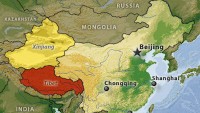Xinjiang Struck by 5.4 Magnitude Earthquake
| Kwao Peppeh | | Jun 25, 2015 09:59 AM EDT |
(Photo : Photo by Andrew Wong/Getty Images) A young earthquake survivor stands amidst the rubble of what used to be his home on June 4, 2008 in Shifang, Sichuan province, Xinjiang has been hit with a 5.4 magnitude earthquake on June 25, 2015.
China Earthquake Networks Center has announced that a 5.4 magnitude earthquake affected parts of Xinjiang in the early hours of Thursday, June 25, Xinhua reported.
Like Us on Facebook
The earthquake, which struck Toksun County just a few minutes past 3:00 a.m., is reported to have had its epicenter at 41.8 degrees north latitude and 88.4 degrees east longitude.
It is unclear if the earthquake caused any major damages in the region, which has vast oil and natural gas reserves. A 2002 census reported that Toksun County had a population of about 110,000.
According to China Earthquake Networks Center, the depth of the earthquake was only 9 kilometers. However, several other seismological monitors, including the European-Mediterranean Seismological Centre (EMSC), have reported that the depth of the earthquake was over 30 kilometers.
Generally, an earthquake with a depth of 0 - 70 kilometers is considered to be shallow. Shallow earthquakes are known to have a more damaging effect on infrastructure than deep or intermediate earthquakes because they usually take longer to dispense off their force and occur considerably closer to the earth's crust.
This is the eight time an earthquake has struck Xinjiang this year, according to data from Earthquake Track.
Experts have pointed out that the injection of unwanted liquid deep into the earth induces seismic activity.
"Global warming and clean energy requirements are promoting applications in which fluids are intensively pumped into deep crustal formations. Fracturing, which results in seismicity, is an essential process in several industrial applications," a research paper about injection-induced seismicity in Zigong, southwestern Sichuan Basin explains.
The paper, which was published in the Journal of Geophysical Research, concludes that between 2009 and 2010, the occurrence of earthquakes in Zigong was closely connected to the injection of unwanted water into the earth. "A total of 130,000 m3 of water has been pressured into the formation during the period from 2009 to July 2010. During this period, more than 7000 earthquakes, among which 5000 events having magnitudes of greater than or equal to 0.5 have been recorded by a nearby local network and five temporary stations," it reads.
TagsXinjiang Earthquake, China Earthquake Networks Center, China earthquake
©2015 Chinatopix All rights reserved. Do not reproduce without permission
EDITOR'S PICKS
-

Did the Trump administration just announce plans for a trade war with ‘hostile’ China and Russia?
-

US Senate passes Taiwan travel bill slammed by China
-

As Yan Sihong’s family grieves, here are other Chinese students who went missing abroad. Some have never been found
-

Beijing blasts Western critics who ‘smear China’ with the term sharp power
-

China Envoy Seeks to Defuse Tensions With U.S. as a Trade War Brews
-

Singapore's Deputy PM Provides Bitcoin Vote of Confidence Amid China's Blanket Bans
-

China warns investors over risks in overseas virtual currency trading
-

Chinese government most trustworthy: survey
-

Kashima Antlers On Course For Back-To-Back Titles
MOST POPULAR
LATEST NEWS
Zhou Yongkang: China's Former Security Chief Sentenced to Life in Prison

China's former Chief of the Ministry of Public Security, Zhou Yongkang, has been given a life sentence after he was found guilty of abusing his office, bribery and deliberately ... Full Article
TRENDING STORY

China Pork Prices Expected to Stabilize As The Supplies Recover

Elephone P9000 Smartphone is now on Sale on Amazon India

There's a Big Chance Cliffhangers Won't Still Be Resolved When Grey's Anatomy Season 13 Returns

Supreme Court Ruled on Samsung vs Apple Dispute for Patent Infringement

Microsoft Surface Pro 5 Rumors and Release Date: What is the Latest?













